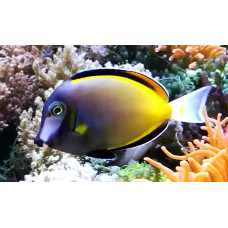Latin name
Acanthurus japonicus
Other name
White-faced surgeonfish, gold rim tang, powder brown tang, white-nose surgeonfish
Identification
Have a laterally compressed oval body with long dorsal and anal fins.
Features of fish fins
The dorsal fin is supported by 9 spines and 28 to 31 soft rays, while the anal fin is supported by 3 spines and 26 to 29 soft rays. The caudal fin is truncated.
Fish colouring
The color of this fish depends on its emotional state and can be brown, with blue spots and almost yellow, but its most striking feature is the broad white stripe that runs from the bottom of the eye socket to the upper lip. A pink stripe runs along the dorsal fin with soft rays. The caudal peduncle is black with a yellow base. The bases of the pectoral fins are yellow.
Distribution
Found in the western Pacific Ocean from southern Japan south to the island of Sulawesi in Indonesia.
Habitat
Marine tropical species. These fish can be found in small schools at depths of 1 to 20 m in the clear waters of lagoons and nearshore reefs.
Size
The maximum published total length of this species is 21 cm (8.3 in).
Behavior
Occupies clear lagoons and nearshore reefs, usually in shallow open water. Occurs in small and large schools. Sometimes solitary.
Food and feeding habits
They feed on algae.
Reproduction
There is no information about their breeding and captive breeding.
Fishing
Have negligible commercial value in the fishery.
Relationship with a person
A species not harmful to humans. Used in aquaristics.
| Classification | |
| Phylum | Chordata |
| Class | Actinopterygii |
| Squad | Acanthuriformes |
| Family | Acanthuridae |
| Genus | Acanthurus |
| Species | A. japonicus |
| Features | |
| Conservation status | Least Concern |
| Habitat | Pelagic |
| Life span, years | No information |
| Maximum body weight, kg | No information |
| Maximum length, cm | 21 |
| Sailing speed, m/s | No information |
| Threat to people | Not edible |
| Way of eating | Bentophage |
Japan surgeonfish
Tags: japan surgeonfish



